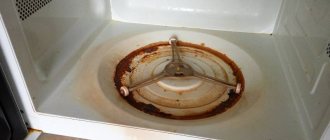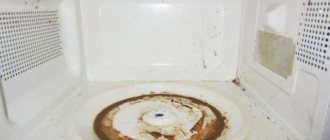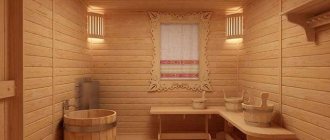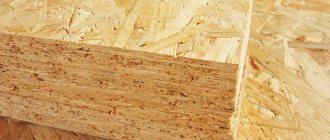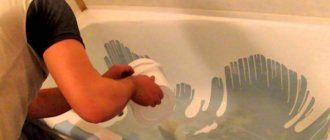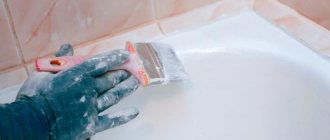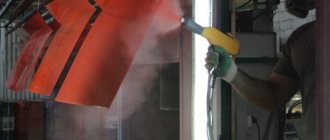Rust stains are not a reason to throw away your microwave. The inner surface can be painted, thereby extending the life of the household appliance.
So, how to paint the inside of a microwave from rust at home?
What colors are there?
There are several types of paints that can be used to restore the inside of a microwave oven.
Food grade or organic
The best option for painting the inside surface of a microwave is food-grade, organic enamel.
Made on the basis:
- silicone varnish,
- ethyl silicate alcohol solution,
- color pigment,
The paint perfectly withstands sudden changes in temperature and humidity, and does not release toxic substances hazardous to human health when heated.
Food-grade enamel adheres perfectly to aluminum surfaces and is approved for use by the Ministry of Health.
Electrically conductive
Conductive paints include aluminum, zinc and even silver . When dry, electrically conductive enamel coats the inside surface of the microwave with a thin but very durable layer that is resistant to high temperature and humidity.
Shungite
Particularly durable, dense in structure, shungite paint is particularly heat resistant (withstands heating up to +300°C), has electrically conductive properties, this paint :
- absolutely safe for health,
- does not emit toxic substances,
- does not burn.
By covering the inner surface of the microwave, it helps not only to remove existing defects (chips, abrasions), but also creates a durable, energy-saving layer.
Acrylic car
Acrylic car paints have gained particular popularity due to their simplicity and ease of application (the paint is sold in aerosol cans), as well as its availability (the cost is low compared to other enamels).
A wide color palette of car paints allows you to perfectly match the desired shade .
Acrylic car paint (or rather a primer) creates a durable layer on the inside surface of the microwave that is resistant to high temperatures.
Which one and when to choose?
At the slightest spots of rust, the surface must be coated with paint (this will help stop the corrosive destructive process).
Suitable paint for a microwave oven is:
- composition without harmful, toxic substances (when heated, they are released into the environment, causing irritation of the mucous membranes and even poisoning of the body);
- composition with high resistance to high temperatures and humidity;
- a composition whose color matches the shade of the previous coating.
Before purchasing, do not forget to study the manufacturer's label on the paint can.
Top 5 best
Construction hypermarkets offer a wide selection of metal paints. TOP 5 best paint options for painting the inside surface of a microwave:
KUDO
Heat-resistant enamel KUDO organosilicon . Ideal for painting metal surfaces. Due to the fact that the enamel is sold in an aerosol can, the composition is easily applied to hard-to-reach places.
The paint layer can withstand heating temperatures up to 650°C. The enamel dries quickly under natural conditions, does not crack or peel, and creates a perfectly smooth surface.
The average cost is 160 rubles. (570 ml can). Read reviews here.
Decorix
Decorix universal acrylic enamel is a high-quality composition intended for painting:
- metal,
- glass,
- mineral surfaces.
After application, it forms a thin but very durable coating that is resistant to fading and high temperatures. Dries quickly (one coat - thirty minutes). A variety of enamel shades allows you to select the desired option in each specific case.
The average cost of a can of enamel (520 ml) is 200 rubles. Read reviews here.
Elcon
Elcon heat-resistant enamel is intended for painting metal surfaces that are subject to sudden temperature changes and high humidity during operation.
The paint is resistant to aggressive environments (mineral oils, soluble salts). Can be used for painting household appliances (does not emit toxic fumes). Complete drying time does not exceed 72 hours.
The average cost is 470 rubles. (1 liter jar). Read reviews here.
Certa
Paint Spectrum Certa heat-resistant enamel is an excellent solution for treating metal surfaces exposed to high temperatures (up to +1000°C).
In addition to thermal insulation properties, the paint has high protection against moisture and aggressive environments. No primer required during application.
The average cost is 350 rubles. (spray can 520 ml). You will find reviews here.
Panzer
Panzer rust paint contains components that smooth out rust-affected surfaces, forming a perfectly smooth coating that is resistant to high temperatures. The paint is environmentally friendly and suitable for interior work.
The average cost of a can of paint (volume 750 ml) is 650 rubles. You will find reviews here.
How to paint?
To achieve the most durable, smooth inner surface of the microwave, it is important to follow a certain sequence of actions .
Preparatory stage
The preparatory process is an important stage, the quality of which determines the final result of painting the inner surface of the microwave.
In addition to paint in a can or spray can, you need to prepare:
- brush or narrow roller;
- alcohol-containing product or solvent (necessary for degreasing the surface);
- fine-grained sandpaper;
- masking tape;
- protective gloves and glasses.
If a large area of the microwave is affected by rust, an acid converter will help to quickly remove it.
Once everything necessary for work is prepared, you need to carry out the following steps:
Unplug the household appliance from the outlet.- Cover with tape those elements that should not be touched by paint (ventilation window, lock and hinges, glass on the door).
- All places where the paint has peeled off and rust has appeared are thoroughly cleaned (sandpaper is used for this process).
- After traces of corrosion have been cleaned, the inner surface is wiped with a cloth to remove dust and dirt.
- Using a soft sponge or rag soaked in an alcohol-containing composition or solvent, degrease the surface to be painted.
Work with solvents is carried out only with gloves and in a well-ventilated area.
Coloring
Painting the inner surface of the microwave begins from the far wall, smoothly moving towards the door. It is important to apply the paint in a very thin layer (in this case it dries faster) . To do this, use a small foam roller or enamel in a spray can.
Use a thin brush to paint only the corners inside the household appliance. When using spray paint, you must ensure that your hand does not linger in one position (the movements should be zigzag).
After the first coat of paint has been applied, it is important to wait for it to dry completely and only then can the second coat be applied.
At the end of the restoration work, the household appliance is left aside for some time so that the paint dries thoroughly. Only after this can you remove the masking tape from the microwave (otherwise there is a high risk of smearing wet paint over the surface).
If smudges or paint stains are found on the walls of the microwave, they can be carefully removed by wiping with a cotton swab dipped in solvent.
This video will show you how to paint the inside of a microwave:
Care instructions
During the first three days you cannot use the microwave; you must wait until the paint has completely dried. In the future, dirt and grease should be washed off immediately, not dried, since the painted base is less resistant to cleaning than the factory coating.
Do not use too hot or cold water for washing; it is better to use warm water. Aggressive agents, chemicals, hard brushes are prohibited! If you follow these tips, you can use the device for several years, the microwave will work flawlessly.
What to do to prevent rusty deposits from appearing again?
You can extend the life of a microwave oven, subject to certain rules:
- Do not use abrasive dry powders when cleaning the internal surface. They leave scratches that will soon become covered with a rusty coating.
- The microwave oven must be cleaned regularly. Acidified fat and other contaminants destroy the inner surface (the enamel begins to bubble and peel), which leads to the rapid appearance of rust spots.
- To make the microwave less dirty when heating food, the plate must be covered with a special plastic lid.
- Cleaning with warm water will prevent the interior surface of the microwave from prematurely showing signs of corrosion (cold water causes the enamel to crack faster).
Careful, regular maintenance guarantees the safety of the inner surface of the microwave from rust.
Causes of coating deformation
Fat and food debris accumulate on the walls of the heat chamber, so the surface must be washed regularly. Using a hard brush and abrasive detergents will lead to deformation. What to do if chips appear inside the microwave or the enamel is cracked? It is necessary to immediately begin restoring the coating material.
Damage to the integrity of the enamel is a catalyst for worsening the problem. Scratches and other damage will contribute to corrosion and rust. It is possible that other defects will appear. Their specificity largely depends on what material the walls of the heat chamber are made of. Microwave paint is the optimal solution to the problem.
Adviсe
A few tips will help improve the quality of painting the inside of a microwave from rust:
After painting, the microwave oven cannot be used for three days. Ignoring this condition may cause cracks in uncured paint.- When painting a microwave, the table on which the household appliance stands and the flooring around it must be covered with plastic wrap. This will help avoid additional cleanup after painting work.
Restoration work must begin as soon as the first spots of rust appear. Otherwise, there is a high risk of rapid spread of corrosion and complete failure of the household appliance.
Is it possible to use a microwave with damaged enamel?
A reasonable question that arises among owners of a microwave oven that has scratches is whether it is possible to use such a device? A small number of defects does not interfere with the use of the stove, but in any case they will increase over time due to high temperature exposure. A layer of microwave paint inside serves to protect food from electromagnetic radiation.
For this reason, repair work is necessary, otherwise eating food heated in such a microwave will be harmful. The enamel itself, which has peeled off, will not cause harm, but electromagnetic waves are unsafe. Therefore, either the equipment will need to be disposed of, or the paint layer from the inside will need to be restored.
Also, rust and cracks will lead to interruptions in operation, and eventually the stove will break.
A small number of defects does not interfere with the use of the stove, but in any case they will increase over time due to high temperature exposure.
